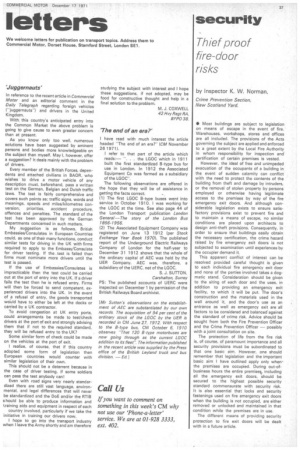letters
Page 39

If you've noticed an error in this article please click here to report it so we can fix it.
We welcome letters for publication on transport topics. Address them to Commercial Motor, Dorset House, Stamford Street, London SE1.
'Juggernauts'
In reference to the recent article in Commercial Motor and an editorial comment in the Daily Telegraph regarding foreign vehicles (-juggernauts-) and drivers in the United Kingdom.
With this country's anticipated entry into the Common Market the above problem is going to give cause to even greater concern than at present.
As you know only too well, numerous solutions have been suggested by eminent persons and bodies more knowledgeable on the subject than myself. May I. however, offer a suggestion? It deals mainly with the problem of drivers.
Every member of the British Forces, dependents and attached civilians in BAOR, who wishes to drive a motor vehicle of any description must, beforehand, pass a written test on the German. Belgian and Dutch traffic laws. The test is fairly comprehensive and covers such points as: traffic signs, words and meanings. speeds and miles/kilometres conversion, priorities, accident procedure. offences and penalties. The standard of the test has been approved by the German Departments concerned in such matters.
My suggestion is as follows. British Embassies/Consulates in European Countries could, as one of their many functions, conduct similar tests for driving in the UK with firms required to apply to the Embassy/Consulate for driver testing. If the test is failed then firms must nominate more drivers until the test is passed.
If the use of Embassies/Consulates is impracticable then the test could be carried out at the port of entry into the UK. If a driver fails the test then he is refused entry. Firms will then be forced to send competent, experienced drivers into the UK. In the event of a refusal of entry, the goods transported would have to either be left at the docks or carried by a UK contractor.
To avoid congestion at UK entry ports, could arrangements be made to test/check drivers at the port of exit and strongly advising them that if not to the required standard. they will be refused entry to the UK?
Some similar form of check could be made on the vehicles at the port of exit.
I realize, of course, that if this country adopted some form of legislation then European countries would counter with similar legislation of their own.
This should not be a deterrent because in the case of driver testing, if some soldiers can pass the test anybody can I Even with road signs very nearly standardized there are still vast language, environmental. and legal differences that will never be standardized and the DoE and/or the RTIB should be able to produce information and training aids and equipment in respect of each country involved, particularly if we take the initiative in training our drivers now.
I hope to go into the transport industry when I leave the Army shortly and am therefore studying the subject with interest and I hope these suggestions, if not adopted. may be food for constructive thought and help in a final solution to the problem.
M. J. COXWELL 42 Hvy Regt RA, BFPO 38.
The end of an era?'
I have read with much interest the article headed "The end of an era?" (CM November 26 1971).
I refer to that part of the article which reads:— ". . . the LGOC which in 1911 built the first standardized B-type bus for use in London. In 1912 the Associated Equipment Co was formed as a subsidiary of the LGOC-.
The following observations are offered in the hope that they will be of assistance in getting the facts correct.
(1) The first LGOC B-type buses went into service in October 1910. I was working for the LGOC at the time. See also page 44 of the London Transport publication London General—The story of the London Bus 1856-1956.
(2) The Associated Equipment Company was registered on June 13 1912 (per Stock Exchange Year Book 1970). The published report of the Underground Electric Railways Company of London for the half-year to December 31 1912 shows that the whole of the ordinary capital of AEC was held by the UER Company. AEC was, therefore, a subsidiary of the UERC. not of the LGOC.
S. J. SUTTON, Carshalton, Surrey PS: The published accounts of UERC were inspected on December 1 by permission of the British Railways Board archivist.
(Mr Sutton's observations on the establishment of AEC are substantiated by our own records The acquisition of 94 per cent of the ordinary stock of the LGOC by the UER is recorded in CM June 27. 1912. With respect to the B-type bus, CM October 6, 1910 observes "That 120 B -type motorbuses are now going through as the current LGOC addition to its fleet". The information published in the recent article was supplied by the Press office of the British Leyland truck and bus division. — Ed,
































































































